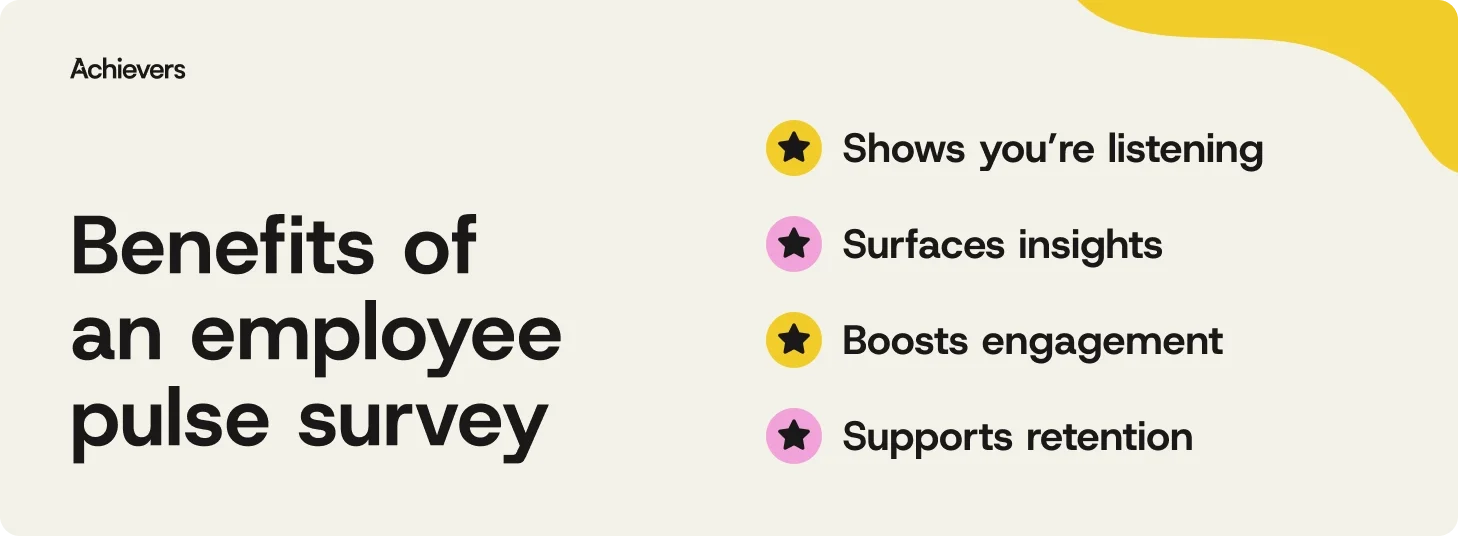Table of contents
Create a culture that means business™
Schedule a demo with an Achievers solution expert today.
An employee pulse survey is like a workplace temperature check — but instead of asking “How are you?” and moving on, it actually listens. These short, frequent surveys surface what your people are feeling right now, not months after the moment’s passed.
Still, most companies are behind the curve. Our research found that 43% only run surveys once a year — and nearly 60% of employees want more frequent check-ins. That’s a big disconnect for something as crucial (and changeable) as engagement.
Because engagement isn’t static. It shifts with recognition, leadership, workload — even whether anyone said “nice work” this week. Pulse surveys give you a chance to catch those shifts early and do something about them.
Let’s break down the key benefits of employee pulse surveys — and why more frequent listening helps organizations stay agile, connected, and ready to act.
10 benefits of an employee pulse survey
So, why are more companies making employee pulse surveys a core part of their people strategy? Because when done right, they don’t just gather feedback — they fuel action, build trust, and help you stay ahead of the curve (and the turnover).
Here are 10 benefits of employee pulse surveys that show just how powerful frequent listening can be — for your people and your business.

1. Shows employees you’re actually listening
Running pulse surveys signals something important: your people matter, and their voices do too. Regularly gathering feedback shows commitment — but only if you follow through. Otherwise, you’re just collecting opinions that gather digital dust. Need proof? Gallup found that only 8% of employees strongly believe their company acts on survey feedback. Want to be in that 8%? Don’t just ask — act.
2. Surfaces insights — fast
Because pulse surveys are short and frequent (think 5–15 questions), they make it easy to catch issues early and often. You’ll get more honest answers, better participation, and a faster path to insights you can actually use. The bonus? Quick turnaround leads to quicker action — and that builds trust.
3. Boosts engagement
Feedback without action is frustrating. But when employees see their input spark real change, engagement climbs. According to Achievers’ Engagement and Retention Report, 41% of employees surveyed more than four times a year say they’re very engaged. Frequent listening, paired with timely response, builds advocacy, commitment, and — yes — enthusiasm.
4. Supports retention
When you know what’s bothering your people, you can fix it before they start refreshing LinkedIn. Pulse surveys uncover early signs of employee disengagement, low morale, or friction — all of which fuel turnover. And with nearly 2 in 3 employees considering a job change, that visibility matters more than ever.
5. Flags issues before they escalate
Whether it’s burnout, communication breakdowns, or a disconnect with leadership, pulse surveys help you catch concerns while they’re still fixable. You don’t need a 40-page report to know if teams feel unsupported or siloed — you just need to ask the right questions, regularly.
6. Encourages honest feedback
Let’s be real: most people aren’t going to tell their manager they’re unhappy — especially if the manager’s part of the problem. But they will be honest in a survey. In fact, our pulse survey research found that 77% of employees say they’d rather share candid feedback for their managers via a survey than face-to-face. That honesty fuels a stronger culture — if you’re ready to hear it.
7. Fuels a culture of continuous improvement
Every pulse survey is an opportunity to course-correct. Over time, those snapshots turn into trends — and trends shape strategy. Frequent feedback helps managers and leaders focus on what’s working, what’s not, and what needs to change to keep performance (and people) on track.
8. Reduces bias
Bias sneaks into traditional feedback — from who’s asked to how it’s interpreted. But pulse surveys level the playing field. Anonymity and standardized questions help remove subjectivity, so you get clearer, more accurate insights about what’s really going on.
9. Makes your next move smarter
Pulse surveys don’t just tell you how people feel — they show you where to focus. With targeted data in hand, leaders can move from guesswork to game plan, designing actions that actually address what’s off. Think of it as turning raw feedback into a strategic roadmap.
10. Drives higher participation
Let’s face it — no one loves a 60-question marathon. But short, thoughtful pulse surveys? People actually complete them. When surveys are easy to engage with, feedback flows more freely — and more frequently.
What makes a pulse survey a pulse survey?
Not all surveys are created equal. Pulse surveys stand out because they’re built for speed, focus, and action — not for collecting dust in a shared drive. Here’s what sets them apart:
- Frequent by design: Whether it’s weekly, bi-weekly, or monthly, pulse surveys run on a regular cadence — so you’re not relying on a once-a-year gut check to understand how your people are doing.
- Short and to the point: Nobody wants to answer 47 questions before their first coffee. Pulse surveys keep it brief — usually just a handful of questions — making them easy to complete and hard to ignore.
- Focused on what matters: Want to understand how employees feel about their manager? Culture? Flexibility? Recognition? Pulse surveys let you zero in on specific topics, so you can stop guessing and start fixing.
- Always-on insights: Because they’re short and frequent, pulse surveys give you a steady stream of real-time feedback — so you’re always working from what’s actually happening, not what happened months ago.
An employee pulse survey belongs in your toolkit
An employee pulse survey isn’t just a way to gather feedback — it’s a way to show employees their voice matters. And when people feel heard, they’re more likely to stay engaged, stay motivated, and stick around.
If you’re looking for a lightweight, high-impact way to stay in sync with your workforce, pulse surveys are a smart place to start. Ask with intention, listen with care, and act with purpose — that’s how you turn feedback into something meaningful.
You don’t need to overhaul your entire strategy. Just start by asking the right questions — and really listening to the answers.


